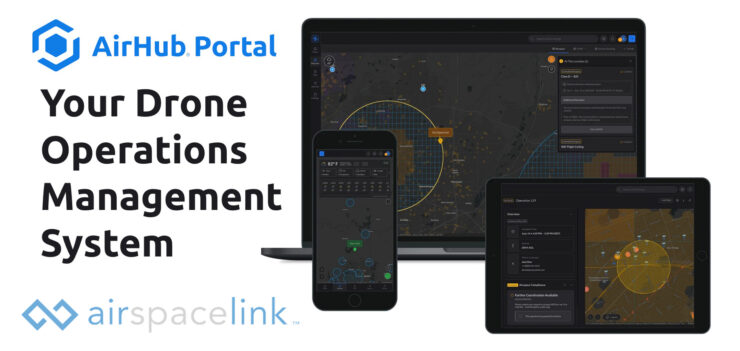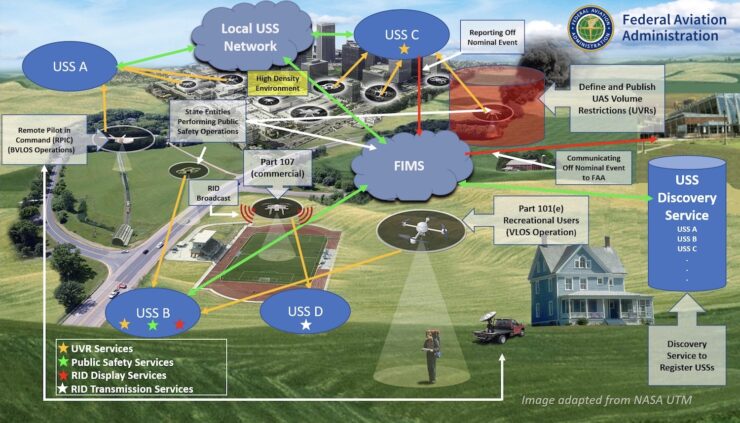
AirspaceLink’s AirHub Platform
An avid fan of drones with a background in geospatial technology, Michael Healander recognized a gap between emerging drone operations and local government infrastructure. He envisioned a platform that could connect aviation and ground data in a way that would make drone integration both scalable and safe. In 2018, he founded Airspace Link in Detroit, Michigan to build this platform. “Our mission,” the company’s website states, “is to enable the safe integration of drones into the national airspace and communities at scale through digital infrastructure, strategic partnerships, and thought leadership.” Airspace Link FAA NTAP approval is a key milestone in advancing BVLOS operations and UTM readiness.
Airspace Link has developed a comprehensive suite of digital tools designed to support both regulators and operators. Its flagship platform, AirHub, provides real-time mapping, risk analysis, and operational planning services for commercial drone flights. By integrating local ordinances, federal aviation data, and ground intelligence, the company helps cities and drone operators manage flights safely over communities.
Airspace Link FAA Programs and NTAP Approval
A key part of that effort involves working with the Federal Aviation Administration’s (FAA) Low Altitude Authorization and Notification Capability (LAANC), a system that automates approvals for drone flights in controlled airspace near airports. As an authorized LAANC provider, Airspace Link allows pilots to receive rapid clearance for drone flights under 400 feet, reducing wait times from weeks to seconds. The company also contributes to B4UFLY, the FAA’s public app that informs recreational pilots about flight restrictions and airspace classifications in real time.

B4UFly Phone App
On September 30, Airspace Link announced that it has received FAA Notice to Air Missions Authorization Program (NTAP) approval as an Unmanned Aircraft System Traffic Management (UTM) service provider for Beyond Visual Line of Sight (BVLOS) strategic deconfliction. This designation allows Airspace Link to support more complex drone operations. NTAP is the FAA’s vetting program for third-party suppliers that want to deliver UTM services directly to operators and other stakeholders.
How UTM Works
UTM is a digital framework developed by the FAA and NASA to coordinate drone flights at scale. Unlike traditional air traffic control, which manages crewed aircraft in higher altitudes, UTM operates as a distributed network of service providers that share data on flight intent, airspace constraints, and operational plans.

© FAA – UPP High-Level Operational Concept
This coordination enables multiple drone operators to fly simultaneously without conflicts, even in busy urban environments. Strategic deconfliction involves detecting and resolving potential conflicts between planned drone flights before they occur, which is crucial for enabling routine operations such as package delivery, infrastructure inspections, and emergency response.
“UTM is the digital infrastructure that will let drones scale safely and predictably in our communities,” Healander said. “Completing NTAP approval is a major step forward for our customers and partners.”
This approval makes Airspace Link one of a select group of companies authorized to provide UTM services for BVLOS operations. “This means that AirHub Portal can exchange drone operations flight intent across a collaborative digital network, so drone deliveries, inspections, and public safety missions can launch faster, avoid conflict, and earn public trust,” Healander added. The Airspace Link FAA NTAP approval strengthens AirHub’s role within a cooperative UTM ecosystem.
Preparing for Part 108 and Part 146
As the FAA moves toward implementing Part 108, which will set the operational framework for BVLOS flights, and Part 146, which will outline requirements for UTM services, Airspace Link’s NTAP designation signals growing confidence in the role of private industry to help manage drone traffic. This approval enhances the capabilities of its AirHub Portal. The platform can now communicate operational data with other UTM providers, allowing it to become part of a broader cooperative network. “We’re ready for what’s next under Part 108 and Part 146 and already delivering it today,” Healander said.
This interoperability is essential as the drone industry grows. For regulators, it represents a shift from a centralized air traffic control model toward a federated digital ecosystem where multiple service suppliers share responsibility for maintaining safe skies. For operators, this means faster approvals, reduced risk of delays, and the ability to scale missions beyond pilot sightlines.
Positioning for the Future of Drone Regulations
Airspace Link’s NTAP approval comes at a pivotal time for the industry. The FAA is expected to release new BVLOS regulations that will enable routine commercial operations across the United States. Companies that are already authorized as UTM providers will be well positioned to support these missions from day one. Airspace Link’s integration of local ground data with federal airspace systems gives it a strategic advantage as cities and operators prepare for expanded drone services, while simultaneously providing transparency, operational safeguards, and the building blocks for other companies to follow suit.
|